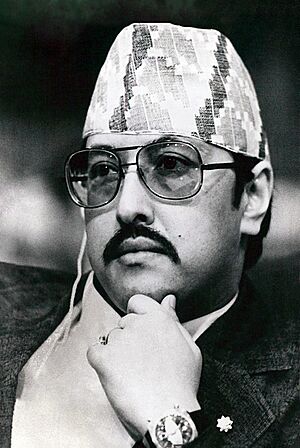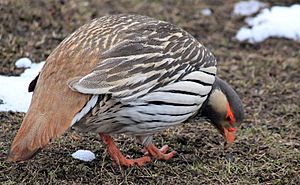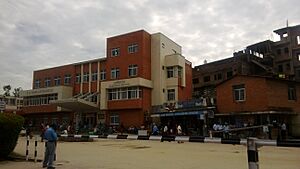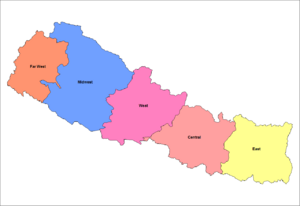Birendra of Nepal facts for kids
Quick facts for kids Birendra Bir Bikram Shah Dev |
|||||
|---|---|---|---|---|---|

Birendra c. 1967
|
|||||
| King of Nepal | |||||
| Reign | 31 January 1972 – 1 June 2001 | ||||
| Coronation | 24 February 1975 | ||||
| Predecessor | Mahendra | ||||
| Successor | Dipendra | ||||
| Born | 28 December 1945 Narayanhiti Royal Palace, Kathmandu, Nepal |
||||
| Died | 1 June 2001 (aged 55) Narayanhiti Royal Palace, Kathmandu, Nepal |
||||
| Cause of death | Assassination (gunshot wounds) | ||||
| Spouse | |||||
| Issue | King Dipendra Princess Shruti Prince Nirajan |
||||
|
|||||
| Dynasty | Shah | ||||
| Father | Mahendra | ||||
| Mother | Indra Rajya Lakshmi Devi | ||||
| Religion | Hinduism | ||||
Birendra Bir Bikram Shah Dev (Nepali: श्री ५ महाराजाधिराज वीरेन्द्र वीर विक्रम शाह देव) was the tenth King of Nepal. He ruled from 1972 until his death in 2001. He was the oldest son of King Mahendra. Many people remember him as a king who brought many changes to Nepal.
Contents
Early Life and Education
Birendra was born on December 28, 1945. His birthplace was the Narayanhiti Palace in Kathmandu. He was the first son of Crown Prince Mahendra and Crown Princess Indra Rajya Lakshmi Devi.
He went to St. Joseph's School in Darjeeling for eight years. His brother Gyanendra also studied there. In 1955, his grandfather, King Tribhuvan, passed away. His father then became the King of Nepal. This made Birendra the crown prince, meaning he would be the next king.
In 1959, Birendra went to Eton College in the United Kingdom. After finishing there in 1964, he returned to Nepal. He explored his country by walking to faraway villages. He lived simply, using only what was available there. He continued his studies at the University of Tokyo. Later, he studied political ideas at Harvard University from 1967 to 1968.
Birendra loved to travel when he was young. He visited many countries in North America, South America, Africa, and Asia. He also collected art and supported Nepalese artists. He even learned how to fly helicopters!
On February 27, 1970, Birendra married Aishwarya Rajya Lakshmi Devi. She was his second cousin from the Rana family. Their wedding was a very grand event.
Reign as King
Becoming King
Birendra became the King of Nepal on January 31, 1972. He was 27 years old when his father, King Mahendra, died. His official crowning ceremony, called a coronation, happened later. It took place on February 24, 1975, when he was 29. This delay was because the first year was a time of mourning. The second year was also thought to be unlucky by religious astrologers. As a Hindu king, he followed these traditions.
Ruling Nepal
When Birendra first became king, he had almost complete power. Political parties were not allowed in Nepal. He ruled through a system of local councils called panchayats.
Over time, people started asking for more freedom. Student groups began to demand changes to the government. Because of this growing movement for democracy, King Birendra made an important announcement. He said there would be a public vote, called a referendum. People would choose between the current system or a system with many political parties. The vote happened in May 1980. The system without parties won by a small amount. After this, the king made big changes to Nepal's economy and government. He divided the country into five development regions. He visited each region once a year to help with balanced growth.
Moving Towards Democracy

In 1990, many protests and strikes for democracy happened in Nepal. Because of these events, King Birendra made a big decision. He allowed political parties to be active again in April 1990. He agreed to become a constitutional monarch. This meant he would be the head of state, but the government would be run by elected officials.
He created a group to write a new constitution. This new constitution was approved on November 9, 1990. It changed Nepal into a constitutional monarchy with a multi-party democracy. As a constitutional monarch, Birendra became even more popular. However, he could not stop the Nepalese Civil War. This was a conflict between Maoist rebels and government forces. It lasted from 1996 to 2006.
A Tragic Event
King Birendra and members of his close family died in a tragic event. This happened on June 1, 2001, at the Narayanhiti Palace. This palace was where the royal family lived. His son, Crown Prince Dipendra, was then announced as King. However, he was in a coma and passed away a few days later. Since no other royal family member wanted to take the throne, Gyanendra Bir Bikram Shah Dev became the new king.
Notable Works and Improvements
Working with Other Countries

King Birendra worked hard to keep Nepal independent. He managed this even with strong influences from India, China, and the Soviet Union. His first trips as king were to India in October 1973 and China two months later. He helped prevent conflicts between Nepal, China, and Tibet.
He is also remembered for helping to create the South Asian Association for Regional Cooperation (SAARC). This group helps countries in South Asia work together. He also set up the SAARC office in Kathmandu. During his rule, Nepal started diplomatic relations with 46 more countries. This brought the total to 96 countries. He also promoted Nepal as a "zone of peace" at the United Nations. He believed Nepal should have good relationships with both its powerful neighbors, India and China.
Promoting Peace
King Birendra suggested that Nepal should be declared a "zone of Peace" at the United Nations. He thought this because Nepal has a history of peace. It is also the birthplace of Gautam Buddha. This idea was supported by 116 countries. In 1986, he set up a "Peace Keeping Training Camp." This later became the Birendra Peace Operations Training Centre. Nepal now sends trained peacekeepers to work with the UN.
In 1974, King Birendra successfully disarmed a rebel group called the Khampas. They were living in the northern Himalayan region. He gave them land, money, and citizenship if they gave up their weapons. He also stopped the army from being used to fight the Maoist revolution. He believed this would make the situation worse and disturb the peace.
Protecting Nature

King Birendra loved nature and strongly supported protecting it. During his time, the government started focusing on nature conservation. When the number of rhinos dropped, he created a special Rhino Patrol force. This force had armed men and guard posts to protect rhinos in Chitwan. To legally protect rhinos, the Chitwan National Park was created in 1973.

To protect tigers, the Royal Karnali Wildlife Reserve was created in 1976. This later became Royal Bardiya Wildlife Reserve in 1982. Nepal's fourth protected area, Langtang National Park, was also set up in 1976. He also created the Koshi Tappu Wildlife Reserve and the Royal Shuklaphanta Wildlife Reserve in the same year. The Rara National Park was established to protect the unique plants and animals of the Humla, Mugu, and Jumla regions. The Sagarmatha National Park was also created in 1976.
In 1984, the Khaptad National Park was established. The Parsa Wildlife Reserve and the Shey Phoksundo National Park were also created in the same year. To preserve the royal tradition of hunting while protecting wildlife, he established the Dhorpatan Hunting Reserve in 1987. The King Mahendra Trust for Nature Conservation was also set up in 1990.
Thanks to his efforts, Sagarmatha National Park (1979) and Chitwan National Park (1984) became UNESCO World Heritage Sites. Important historical places like the Durbar squares of Kathmandu, Patan, and Bhaktapur were also added in 1979.
Economic Growth
King Birendra focused on building a strong economy. In 1975, a trolley bus system was started in Nepal with help from China. He continued his father's work by setting up industrial areas in many cities. These included Nepalgunj (1973), Pokhara (1974), and Butwal (1976).
He also started the plan for the Melamchi water project for Kathmandu. Many new industries were established during his time. These included Gorakhali Tires, Udayapur Cement, and Nepal Pharmaceuticals. He also helped set up the Nepal Oriental Magnesite factory in 1979. In 1983, he created a Nepal-Pakistan Joint Economic Commission. This brought important foreign investments to Nepal.
A 60 Megawatt hydropower project at Kulekhani started in 1982. It received money from the World Bank, Kuwait, and Japan. The TU Teaching Hospital was built in 1982 with support from Japan. Other hospitals like Nardevi Ayurvedic Hospital (1974) and Nepal Police Hospital (1983) were also established.
In 1976, he set up the Securities Exchange Center Ltd. This helped manage and grow the stock market in Nepal. It later became the Nepal Stock Exchange. He also helped establish Nepal Television in 1984, Nepal's first TV channel. By 1986, there were over 2,000 industrial businesses in the country.
In 1986, King Birendra established Mahendra Sanskrit University. This university was created to manage Sanskrit education in Nepal.
Roads and Transportation
Studies in 1972 showed that building roads in hilly areas was very expensive. So, the government decided to connect rural areas with airports first. Roads would be built later where there was a lot of traffic. Under this plan, several airports were built in 1973. These included Baglung Airport, Dhorpatan Airport, and Mahendranagar Airport. More airports like Sanphebagar Airport (1975) and Simikot Airport (1977) were also built. The Lamosangu-Jiri road, leading to Solukhumbu, was completed in 1985 with help from Switzerland.
Boosting Agriculture
King Birendra's government focused strongly on promoting agriculture. By 1990, almost 90% of the population worked in agriculture. This led to more food supplies and better nutrition. Corn production doubled from 1961 to 1991. The Lumbini Sugar Mills was built in 1982 with technical help from China. The establishment of Gorakhali rubber Industries led to rubber farming in eastern Nepal. Many industries based on agriculture, like Bhrikuti Pulp and Paper, were also set up. These greatly helped the economy.
Political Achievements
During King Birendra's rule, a referendum was held in 1980. People voted on whether to have a multi-party system or the Panchayati system. After the referendum, he divided Nepal into five development regions. He visited each region every year to help with balanced growth. These visits stopped after the 1990 democracy movement.
Even though he had a lot of power at first, King Birendra always tried to follow the constitution. He did not overstep his role as a constitutional monarch. He was always there during political problems in Nepal. He often asked the Supreme Court for advice on constitutional matters. He also started a tradition where the king and prime minister met every Thursday. They would discuss important state matters.
Social Improvements
King Birendra believed that low education levels were a big problem. So, he made improving education a top goal. Starting in 1971, five-year plans focused on building new schools. They also worked on making the education system better. For his coronation, King Birendra announced that primary education would be free for all Nepalese citizens. In 1978, all school materials also became free.
He became the patron of the Nepal Academy of Science and Technology. This academy worked to develop science and technology in Nepal. He established Mahendra Sanskrit University in 1986 to preserve the Sanskrit language and culture. The dowry system was made illegal in Nepal in 1976. King Birendra also started a policy called National Service. This required post-graduate students to work for one year in rural areas. He also helped preserve history by establishing the Natural History Museum of Nepal in 1975.
Development Policy
Birendra decided to build roads based on population and traffic. He also focused on connecting rural areas with airports. He changed many government organizations to help achieve development goals. He emphasized building roads, improving sanitation, and providing scientific and technical training. The National Planning Commission was restructured in 1972 and 1987. The government mainly focused on protecting the environment, agriculture, and education.
Personality
Birendra's teachers at Eton College described him as a very kind prince. His classmates remembered him as a "very, very nice bloke." They said he was embarrassed when his full title was read out at school. A famous Nepalese media person, Neer Shah, described Birendra as a kind king who loved development. People close to him and scholars say he was a simple king. He was good at listening to other people's ideas. Some also say he was too kind and found it hard to say no to requests.
King Birendra allowed the 1980 Referendum, which was a step towards democracy. Some historians believe that his democratic views helped the People's Movement in 1990 succeed. He is also credited with starting SAARC in Asia. This helped strengthen Nepal's relationships with other South Asian countries.
Memorial
Many places and institutions are named after King Birendra. After the monarchy ended in 2008, some monuments were renamed.
Statues
- Birendra statue, Dhamboji Chowk, (Nepalgunj)
- Birendra statue (Dang)
- Birendra statue, Birendranagar (Surkhet)
- Birendra statue, Swargapuri (Shivapuri)
- Birendra statue, Jawalakhel (Lalitpur)
- Birendra statue, Bindhyabasini Temple (Pokhara)
- Birendra statue, Pashupatinath Temple (Kathmandu)
Schools
- Shree Birendra Higher Secondary School, Bhadrapur, Jhapa
- Shree Birendra Higher Secondary School, Charghare, Nuwakot
- Shree Birendra Sarwajanik Higher Secondary School, Morang
- Shree Birendra secondary school, Lakhantari, Morang
- Shree Birendra secondary school, Belbari, Morang
- Shree Birendra Madhyamik Bidhyalaya, Jhorahat, Morang
- Birendra Secondary School, Katahari, Morang
- Birendra Secondary School, Argakhanchi
- Birendra Secondary School, Dasharathchanda, Baitadi
- Birendra secondary school, Badikedar , Doti
- Birendra Secondary School, Syangja
- Birendra Secondary School, Nuwakot
- Birendra Secondary School, Parbat
- Birendra Sainik Awasiya Mahavidyalaya, Bhaktapur
- Birendra jyoti Secondary School, Solukhumbu Sotang
Colleges
- Birendara Bidhya Mandir Campus, Tikapur, Kailali
- Birendra Multiple Campus, Bharatpur
- Birendra Memorial College , Dharan
- Birendra Multiple Campus
Locations
- Birendranagar, Surkhet
- Birendranagar, Chitwan
- Birendra Chowk , (Birendranagar)
- Birendra chowk, Kageshwari-Manohara Municipality
- Birendra chowk , Phungling Municipality
- Birendra Chowk, Dharan
- Birendra Chowk, Tulsipur, (Dang)
- Birendra Chowk , (Nepalgunj)
- Birendra Chowk , (Itahari)
- Birendra Chowk , (Beni, Myagdi)
- Birendra Lake (Birendra Tal), Gorkha
- Birendra Aishwarya Park, Dhangadi
- Birendra Aishwarya Park, Baglung
Structures
- Birendra Museum, Kathmandu Durbar Square
- Birendra Army Hospital
- Birendranagar Airport
Other Memorials
- Birendra Beer, Zürich
- Birendra Memorial Cup
- Birendra Peace Operations Training Centre
- Birendranagar Jaycees
Images for kids
-
Narayanhiti Palace where the royal family lived.
Honours
- National orders
 Sovereign of the Order of Nepal Pratap Bhaskara
Sovereign of the Order of Nepal Pratap Bhaskara Sovereign of the Order of Ojaswi Rajanya
Sovereign of the Order of Ojaswi RajanyaSovereign of the Order of Nepal Taradisha
 Sovereign of the Order of Tri Shakti Patta
Sovereign of the Order of Tri Shakti Patta Sovereign of the Order of Gorkha Dakshina Bahu
Sovereign of the Order of Gorkha Dakshina Bahu- Most Glorious Mahendra Chain
 Recipient of the King Mahendra Investiture Medal (02/05/1956)
Recipient of the King Mahendra Investiture Medal (02/05/1956)
- Foreign orders
 Thailand: Knight of the Order of the Rajamitrabhorn, (1979)
Thailand: Knight of the Order of the Rajamitrabhorn, (1979) Denmark: Knight of the Order of the Elephant, (17 October 1989)
Denmark: Knight of the Order of the Elephant, (17 October 1989) Japan: Knight Grand Cordon with Collar of the Order of the Chrysanthemum, (1975)
Japan: Knight Grand Cordon with Collar of the Order of the Chrysanthemum, (1975) Cyprus: Grand Cross with Collar of the Order of Makarios III of Cyprus, (1980)
Cyprus: Grand Cross with Collar of the Order of Makarios III of Cyprus, (1980) Kingdom of Laos: Knight Grand Cordon with Collar of the Order of the Million Elephants and the White Parasol, (1970)
Kingdom of Laos: Knight Grand Cordon with Collar of the Order of the Million Elephants and the White Parasol, (1970) Netherlands: Knight Grand Cross of the Order of the Gold Lion of the House of Nassau, (22 March 1975)
Netherlands: Knight Grand Cross of the Order of the Gold Lion of the House of Nassau, (22 March 1975) France: Grand Cross of the Order of the Legion of Honour, (02/05/1983)
France: Grand Cross of the Order of the Legion of Honour, (02/05/1983) Germany: Grand Cross Special Class of the Order of Merit of the Federal Republic of Germany, (1986)
Germany: Grand Cross Special Class of the Order of Merit of the Federal Republic of Germany, (1986) Spain: Knight Grand Cross with Collar of the Order of Carlos III, (19 September 1983)
Spain: Knight Grand Cross with Collar of the Order of Carlos III, (19 September 1983) Pakistan: Nishan-e-Pakistan, (1983)
Pakistan: Nishan-e-Pakistan, (1983) Romania: Grand Cross of the Order of the Star of Romania, (1975)
Romania: Grand Cross of the Order of the Star of Romania, (1975) Chile: Grand Cross with Collar of the Order of Merit of Chile (1989)
Chile: Grand Cross with Collar of the Order of Merit of Chile (1989) Finland: Grand Cross with Collar of the Order of the White Rose, (1988)
Finland: Grand Cross with Collar of the Order of the White Rose, (1988) Egypt: Collar of the Order of the Nile, (1974)
Egypt: Collar of the Order of the Nile, (1974) Yugoslavia: Great Star of the Order of the Yugoslav Star, (2 February 1974)
Yugoslavia: Great Star of the Order of the Yugoslav Star, (2 February 1974) Romania: Knight Grand Cross of the Order of 23 August (1987)
Romania: Knight Grand Cross of the Order of 23 August (1987) United Kingdom: Recipient of the Royal Victorian Chain (23 February 1975)
United Kingdom: Recipient of the Royal Victorian Chain (23 February 1975)
- Association honours
 Japan: Golden Pheasant Award of the Scout Association of Japan, (1978)
Japan: Golden Pheasant Award of the Scout Association of Japan, (1978)
See also
 In Spanish: Birendra de Nepal para niños
In Spanish: Birendra de Nepal para niños
- List of state visits made by Birendra
- Wedding of Birendra and Aishwarya
- Coronation of Birendra





